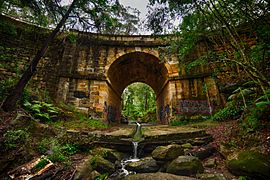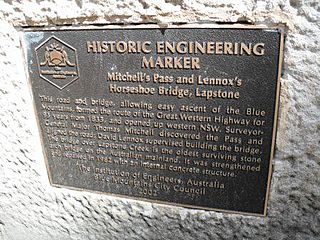Lennox Bridge, Glenbrook facts for kids
Quick facts for kids Lennox Bridge, Glenbrook |
|
|---|---|

The oldest surviving stone arch bridge on the Australian mainland
|
|
| Coordinates | 33°45′15″S 150°37′56″E / 33.75417°S 150.63222°E |
| Carries | Mitchell's Pass (Downhill only) |
| Crosses | Brookside Creek / Lapstone Creek |
| Locale | Glenbrook, City of Blue Mountains, New South Wales, Australia |
| Named for | David Lennox |
| Maintained by | Blue Mountains City Council |
| Characteristics | |
| Design | Arch bridge |
| Material | Stone |
| Width | 9 metres (30 ft) |
| Height | 9 metres (30 ft) at highest point |
| Longest span | 6 metres (20 ft) |
| Number of spans | 1 |
| Load limit | 2 tonnes (2.2 short tons; 2.0 long tons) |
| History | |
| Designer | David Lennox |
| Engineering design by | Thomas Mitchell |
| Construction begin | 1832 |
| Construction end | 1833 |
| Opened | 1833 |
| Closed | 1967-1982 |
| Official name | Lennox Bridge |
| Type | State heritage (built) |
| Criteria | a., b., c., f., g. |
| Designated | 2 April 1999 |
| Reference no. | 24 |
| Type | Road Bridge |
| Category | Transport - Land |
| Builders | James Randall and other convicts |
The Lennox Bridge, Glenbrook is a very old and important road bridge in New South Wales, Australia. It crosses a creek called Brookside Creek (also known as Lapstone Creek) in Glenbrook. This bridge was designed by David Lennox and built between 1832 and 1833. It was built by James Randall and other convicts.
You might also hear it called Lennox Bridge or The Horseshoe Bridge. It's special because it's the oldest stone arch bridge still standing on the Australian mainland. The bridge is made of stone and has a single arch that spans 6 metres (20 feet). It stands 9 metres (30 feet) above the water.
Contents
Building the Bridge
The first road up the Blue Mountains was built in 1814-1815 by William Cox. But it was very steep and often washed away by rain. A new road, the Bathurst Road, was built in 1824. It avoided the creeks but was still very steep and dangerous for travelers.
In 1828, Major Thomas Mitchell became the Surveyor General. He wanted to make the main road to the west much better. He decided to build a new, easier road.
Mitchell chose David Lennox to help build the bridges needed for this new road. Lennox had just arrived in Australia from Scotland. Mitchell was very impressed with him.
Mitchell wrote in 1833: "Mr David Lennox... came with me to my office, and agreed to plan the stone bridges needed."
On October 1, 1832, Lennox was made Sub-Inspector of Bridges. His first big job was to build a bridge over Lapstone Creek on Mitchell's Pass. By November 1832, Lennox and about twenty convicts with building skills had started working. They opened a quarry nearby to get stone. The bridge was designed in a horseshoe shape to make it extra strong.
By March 1833, the bridge was almost finished. Mitchell decided what to carve on the main stones (keystones) of the arch. On the south side, they carved "DAVID LENNOX" to honor the designer. On the north side, they carved "AD 1833" to show the year it was completed. The "AD 1833" stone is still in very good condition today.
Lennox Bridge opened in 1833. It is the oldest stone arch bridge still standing on the Australian mainland. It crosses Brookside Creek on Mitchell's Pass. There was an older crossing about 600 metres (2,000 feet) south, which is now just a walking track. The stone for the bridge likely came from a quarry nearby.
Life of the Bridge
Even though a small crack appeared early on, Lennox said it was nothing to worry about. He was right! The bridge was very strong. It carried more and more traffic as the main road to the west became busier.
After 1867, trains became popular, and less traffic used the road. But in the 1900s, with more cars, Mitchell's Pass became busy again. In 1926, a new road route opened using the Knapsack Viaduct. This helped take a lot of traffic away from Mitchell's Pass.
Mitchell's Pass was still used, and by 1975, Lennox Bridge needed major repairs to keep it safe. Restoration work happened in 1976. The bridge was a main route to the Blue Mountains for 93 years until 1926. It was closed in 1967 but was later made stronger with concrete inside. It reopened in 1982.
What the Bridge Looks Like
Lennox Bridge crosses a deep valley over Lapstone Creek. Its base sits on solid rock. The water flows through a channel that Lennox's convicts cut into the creek bed.
The bridge is not huge, with a single arch spanning about 6 metres (20 feet). The arch is built from carefully shaped stone blocks fitted together with mortar. On the south side of the arch, a special stone (keystone) says "DAVID LENNOX". On the north side, another stone says "AD 1833".
The bridge's roadway is about 9 metres (30 feet) wide. Stone walls (parapets) run along the sides of the bridge. The space between the arch's curve and the flat road was filled with small stones.
During repairs in 1976, the bridge was stripped down to its stone arch. New concrete supports and steel beams were added inside to help carry the weight of traffic. These changes are mostly hidden. New stone blocks were also added, and existing ones were repaired. The original stone channel for the creek is still there, but a concrete channel was poured inside it during the 1976 repairs.
Today, Mitchell's Pass is a one-way road going downhill from Lennox Bridge. It's mostly used by tourists. There's a small parking area next to the bridge. You can walk down a concrete path to the creek on the west side to get great views of the bridge from underneath.
Bridge Condition
As of 2013, the bridge was in good physical condition. Most of its original parts are still there. The repairs done in 1976 did not take away from how important the bridge is.
Changes Over Time
In 1976, the road was closed, and the bridge was taken apart down to its stone arch. The Department of Main Roads decided to remove the stress from the old arch. They rebuilt the road so it was supported by two new concrete walls and steel beams. Other repairs were made to the stonework and the creek channel. The road reopened in 1976, with most of the new work hidden.
Now, with less traffic and the road from the bridge being one-way downhill, Lennox Bridge continues to be the oldest stone bridge on the Australian mainland.
Why This Bridge is Special
Lennox Bridge is very important because it's the oldest stone bridge on the Australian mainland. It shows the amazing skill of its designer, David Lennox, a Scottish stone-mason. He was chosen by the clever Surveyor General, Thomas Mitchell. It also shows the hard work of about twenty skilled convicts who built it.
For over a hundred years, it was a vital part of the road connecting Sydney to the west. It has proven to be incredibly strong and lasting. Its beauty and engineering skill make it even more important. Even with major repairs in 1976, it still looks much like it did originally and is in good condition. These repairs did not spoil its beauty or its clever design. It is important for the whole state because it was the oldest bridge allowing vehicles on a road that was key to New South Wales's growth.
Lennox Bridge was added to the New South Wales State Heritage Register on April 2, 1999.
A Look at History
Lennox Bridge is the oldest stone bridge on the Australian mainland. It shows the skill of David Lennox, a Scottish stone-mason, and the hard work of about twenty skilled convicts. It was a key part of the road system between Sydney and the west for over a century. It is important for the state because it's the oldest bridge for vehicles on a road that was essential for the state's development.
People Connected to the Bridge
David Lennox was born in Scotland in 1788. Before coming to Australia, he spent 17 years building bridges in Britain. In 1832, he arrived in Australia. Soon after, Major Mitchell discovered his talents. On October 1, 1832, Lennox was made Sub-Inspector of Bridges. Within six weeks, he and his team had cut most of the stone and prepared the mortar. By July 1833, the bridge was finished. The bridge's lasting strength shows how successful Lennox's design was. It didn't need major safety work until the 1950s.
Lennox Bridge is also linked to the at least twenty convicts, an overseer, a constable, and an armed guard who worked there from October 1832 to July 1833. The building team worked long hours, cutting and setting stone, and doing carpentry and masonry. After the bridge was done, Lennox asked to keep eight of the convicts. Six of them had their sentences ended early, and the other two had theirs reduced after more work.
Its Beauty and Skill
The original bridge, with its horseshoe curve, was a brave and experimental design, and it was very beautiful. Even though some repairs have changed parts of it, David Lennox's idea for the bridge in this pretty small valley is still very pleasing to look at.
Learning from the Bridge
The bridge was built with a single, half-circle stone arch. The road was about 9 metres (30 feet) wide and the same height above the creek bed. After carrying traffic for over 170 years and having one major repair, it is still strong. The bridge is a great example of David Lennox's work. It was the first scientifically built stone arch bridge of its size in Australia.
A Rare Find
Lennox Bridge is very rare. No other bridges of similar age or design have survived on the Australian mainland.
A Great Example
Lennox Bridge is the oldest scientifically built stone arch bridge on the Australian mainland. Lennox learned how to build bridges before coming to Australia. So, this bridge is a great example of the stone bridge building methods used in England at that time.
Engineering Award
The bridge has received a special award called a Historic Engineering Marker from Engineers Australia. This is part of their program to recognize important engineering achievements.
Gallery



